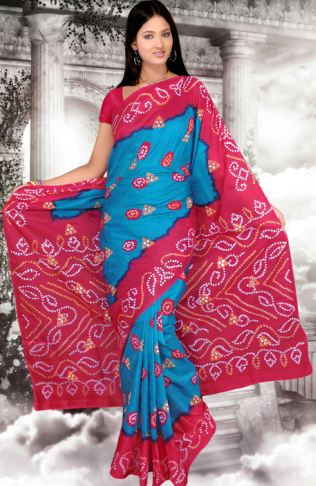Saree, the epitome of grace and elegance, holds a significant place in Indian culture. Among the myriad of saree styles, Bandhani sarees stand out for their captivating colors and intricate designs. Rooted in tradition and steeped in history, Bandhani sarees take us on a mesmerizing journey of vibrant hues and exquisite craftsmanship.
The Art of Bandhani:
Bandhani saree, also known as Bandhej saree or tie-dye, is an ancient textile technique that originated in Gujarat and Rajasthan, India. The word “Bandhani” is derived from the Sanskrit word “bandhana,” meaning “to tie.” This art form involves tying small portions of fabric with thread before dyeing, resulting in stunning patterns and motifs. Bandhani sarees showcase the finest examples of this age-old craft.
Craftsmanship and Techniques:
Creating a Bandhani saree is a labor-intensive process that requires immense skill and patience. It starts with selecting lightweight fabrics such as cotton or silk, which are washed and soaked to ensure purity. The fabric is then marked with intricate designs using chalk or pencil.
The magic of Bandhani lies in the tying process. Highly skilled artisans tie thousands of tiny knots on specific parts of the fabric. These knots create resist points, preventing the dye from permeating the tied areas. The knots can be tied in various ways, including the popular “leheriya” (waves), “beldaar” (dots), “chaubundi” (four corners), and “ekdali” (single knot) techniques. The placement and density of these knots determine the final pattern and design.
Dyeing and Coloration:
After the fabric is meticulously tied, it undergoes the dyeing process. Bandhani sarees are renowned for their vivid and lively colors. Natural dyes derived from plants, minerals, and insects are traditionally used, each holding symbolic significance. The tied fabric is immersed into the dye bath, and the areas without knots absorb the dye, creating a mesmerizing fusion of colors.
Once dyed, the saree is gently rinsed to remove any excess dye and carefully dried. The knots are then painstakingly untied, unveiling the intricate patterns and designs. The tied sections retain the original color of the fabric, creating a striking contrast with the dyed portions. The resulting motifs can range from intricate geometrical patterns to delicate floral designs, showcasing the masterful craftsmanship of the artisans.
Eternal Charm and Versatility:
Bandhani sarees are renowned for their timeless charm and versatility. They are worn on various occasions, including weddings, festivals, and cultural celebrations. The vibrant colorsand exquisite patterns make Bandhani sarees a statement piece that exudes grace and elegance.
Bandhani sarees can be found in a wide range of color combinations, from bold and vibrant hues to subtle pastels. The patterns and designs vary, allowing individuals to choose the one that resonates with their personal style. The versatility of Bandhani sarees also extends to the draping styles, as they can be draped in different ways to create various looks.
Preserving the Legacy:
Despite the evolving fashion trends, Bandhani sarees continue to captivate hearts and maintain their relevance. Artisans and weavers strive to preserve this traditional art form, passing down their skills and knowledge from one generation to another. Various organizations and government initiatives support these artisans, enabling them to showcase their talent and sustain their livelihoods.
In conclusion, Bandhani sarees or Bandhani lehengas are not merely garments; they are embodiments of the rich cultural heritage of India. With their vibrant colors, intricate patterns, and meticulous craftsmanship, Bandhani sarees weave a captivating tale of tradition and artistic expression. They are a true reflection of the vibrant and diverse spirit of India, enchanting all who appreciate their beauty and timeless elegance.
